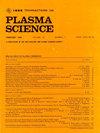Exploration of a High-Efficiency G -Band Klystron Combined With Multigap Cavity and Kladistron Principles
IF 1.3
4区 物理与天体物理
Q3 PHYSICS, FLUIDS & PLASMAS
引用次数: 0
Abstract
In this article, a new bunching method, which was inspired by the kladistron technology, is proposed to enable high-efficiency operation of klystrons in high-frequency bands. This new bunching method combines the kladistron principle and the extended interaction klystron (EIK), and a G-band klystron based on it is designed to verify the new bunching method. Based on the same unit cell, an EIK and a klystron based on kladistron principle are designed for comparison. With a beam current of 0.6 A and a voltage of 18.8 kV, the 3-D particle-in-cell (PIC) results show a maximum output power of 644.41 W and an electron efficiency of 5.71%, which is higher than the EIK (533.66 W and 4.73%) and the klystron based on kladistron principle (554.45 W and 4.92%). The output cavity was optimized by adjusting the positions of the coupling holes and velocity tapering, resulting in a saturated output power of 712.15 W and an electron efficiency of 6.31%.探索结合多隙腔和 Kladistron 原理的高效 $G$-Band Klystron
本文受 kladistron 技术的启发,提出了一种新的束流方法,以实现高频段的高效率运行。这种新的束化方法结合了 kladistron 原理和扩展交互式 klystron (EIK),并设计了一个基于它的 G 波段 klystron 来验证新的束化方法。基于相同的单元,设计了一个 EIK 和一个基于 kladistron 原理的 klystron 进行比较。在束流为 0.6 A、电压为 18.8 kV 的情况下,3-D 粒子入室 (PIC) 结果显示最大输出功率为 644.41 W,电子效率为 5.71%,高于 EIK(533.66 W 和 4.73%)和基于 kladistron 原理的 klystron(554.45 W 和 4.92%)。通过调整耦合孔的位置和速度锥度,对输出腔进行了优化,从而获得了 712.15 W 的饱和输出功率和 6.31% 的电子效率。
本文章由计算机程序翻译,如有差异,请以英文原文为准。
求助全文
约1分钟内获得全文
求助全文
来源期刊

IEEE Transactions on Plasma Science
物理-物理:流体与等离子体
CiteScore
3.00
自引率
20.00%
发文量
538
审稿时长
3.8 months
期刊介绍:
The scope covers all aspects of the theory and application of plasma science. It includes the following areas: magnetohydrodynamics; thermionics and plasma diodes; basic plasma phenomena; gaseous electronics; microwave/plasma interaction; electron, ion, and plasma sources; space plasmas; intense electron and ion beams; laser-plasma interactions; plasma diagnostics; plasma chemistry and processing; solid-state plasmas; plasma heating; plasma for controlled fusion research; high energy density plasmas; industrial/commercial applications of plasma physics; plasma waves and instabilities; and high power microwave and submillimeter wave generation.
 求助内容:
求助内容: 应助结果提醒方式:
应助结果提醒方式:


